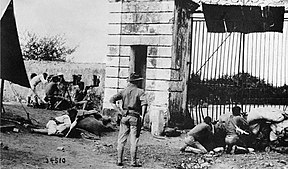
Back احتلال الولايات المتحدة لهايتي 1915 Arabic USA's besættelse af Haiti 1915-1934 Danish Amerikanische Besetzung Haitis German Usona okupado de Haitio Esperanto Ocupación estadounidense de Haití Spanish Yhdysvaltain Haitin miehitys Finnish Occupation d'Haïti par les États-Unis French Okipasyon ameriken an Ayiti, 1915-1934 HT Pendudukan Haiti oleh Amerika Serikat ID Ocupação estadunidense do Haiti Portuguese
| United States occupation of Haiti | |||||||
|---|---|---|---|---|---|---|---|
| Part of the Banana Wars | |||||||
Top to bottom, left to right: United States Marines in 1915 defending entrance gate in Cap-Haïtien, United States Marines and a Haitian guide patrolling the jungle during the Battle of Fort Dipitie, United States Navy Curtiss HS-2Ls and other airplanes in Haiti circa 1919 | |||||||
| |||||||
| Belligerents | |||||||
|
|
| ||||||
| Commanders and leaders | |||||||
|
|
| ||||||
| Strength | |||||||
|
First Caco War: 1,500 U.S. Marines[1] 2,700 Haitian Gendarmes[1] |
First Caco War: 5,000[1] | ||||||
| Casualties and losses | |||||||
|
First Caco War: 146 American deaths[2] |
First Caco War: 2,000+ killed[1] | ||||||
|
3,250–15,000 Haitian deaths[3][4] Hundreds to 5,500 forced labor deaths[5] | |||||||
| History of Haiti |
|---|
| Pre-Columbian Haiti (before 1492) |
| Captaincy General of Santo Domingo (1492–1625) |
| Saint-Domingue (1625–1804) |
| First Empire of Haiti (1804–1806) |
| North Haiti (1806–1820) |
| South Haiti (1806–1820) |
| Republic of Haiti (1820–1849) |
| Second Empire of Haiti (1849–1859) |
| Republic of Haiti (1859–1957) |
| Duvalier dynasty (1957–1986) |
| Anti-Duvalier protest movement |
| Republic of Haiti (1986–present) |
| Timeline |
| Topics |
|
|
The United States occupation of Haiti began on July 28, 1915, when 330 U.S. Marines landed at Port-au-Prince, Haiti, after the National City Bank of New York convinced the President of the United States, Woodrow Wilson, to take control of Haiti's political and financial interests. The July 1915 invasion took place following years of socioeconomic instability within Haiti that culminated with the lynching of President of Haiti Vilbrun Guillaume Sam by a mob angered by his decision to order the executions of political prisoners. The invasion and subsequent occupation was promoted by growing American business interests in Haiti, especially the National City Bank of New York, which had withheld funds from Haiti and paid rebels to destabilize the nation through the Bank of the Republic of Haiti with an aim at inducing American intervention.[citation needed]
During the occupation, Haiti had three new presidents while the United States ruled as a military regime through martial law led by Marines and the Gendarmerie. Two major rebellions against the occupation occurred, resulting in several thousand Haitians killed, and numerous human rights violations – including torture and summary executions – by Marines and the Gendarmerie of Haiti.[citation needed] A corvée system of forced labor was used by the United States for infrastructure projects, that resulted in hundreds to thousands of deaths.[6] Under the occupation, most Haitians continued to live in poverty, while American personnel were well-compensated. The American occupation ended the constitutional ban on foreign ownership of land, which had existed since the foundation of Haiti.
The occupation ended on August 1, 1934, after President Franklin D. Roosevelt reaffirmed an August 1933 disengagement agreement. The last contingent of marines departed on August 15, 1934, after a formal transfer of authority to the American-created Gendarmerie of Haiti.
- ^ a b c d e f g h i Clodfelter (2017). Warfare and Armed Conflicts: A Statistical Encyclopedia of Casualty and Other Figures, 1492–2015. p. 378.
- ^ Hans Schmidt, The United States Occupation of Haiti, 1915-1934 (New Brunswick, NJ: Rutgers University Press, 1995), p. 103; and “Americans Killed in Action,” American War Library, http://www.americanwarlibrary.com/allwars.htm Archived February 22, 2018, at the Wayback Machine. Schmidt cites 146 Marine deaths in Haiti; and the American War Library cites 144 Marines killed in action in the Dominican Republic.
- ^ Hans Schmidt (1971). The United States Occupation of Haiti, 1915–1934. Rutgers University Press. p. 102. ISBN 9780813522036.
- ^ Farmer, Paul (2003). The Uses of Haiti. Common Courage Press. p. 98.
- ^ Cite error: The named reference
Belleau-2016was invoked but never defined (see the help page). - ^ Schmidt, Hans (March 12, 1995). The United States Occupation of Haiti, 1915-1934. Rutgers University Press. ISBN 978-0-8135-2203-6.
© MMXXIII Rich X Search. We shall prevail. All rights reserved. Rich X Search


